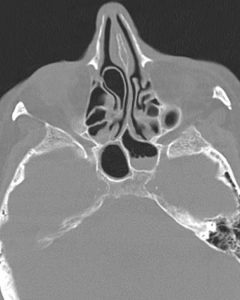Table of Contents
What is a deviated Septum?
Deviated septum is a condition in which the nasal septum that separates your nostrils is displaced on a side rather than staying on the middle.
In a normal person, the nasal septum stays in the middle of the nose and keeps the nostrils the same size. Therefore, it looks abnormal when a septal deviation occurs and some complications arise.
The common complications of a septal deviation may include difficulty breathing, snoring, congestion of the nose, etc.
In this article, we’ll discuss the diagnosis of a deviated septum.
The diagnosis is symptomatic and can be done at home all by yourself. However, if you are unable to diagnose a septal deviation in your home, you may consult a doctor to get it done.
Read Rhinoplasty
Deviated Septum Symptoms
The symptoms of a septal deviation can vary from person to person. Some of the symptoms are very common in can be found in every person who has a deviated septum. the common symptoms of a deviated septum may include;
- Difficulty breathing
- Bleeding from the nose
- Pain in the facial area
- Headache
- Sinus infection (sinusitis)
- Heavy or sharp breathing sound
- Snoring
- Postnasal drip
- Mouth breathing
- Dry nose
- Nasal congestion or obstruction
- Smelly nose
- Loss of smell
- Mucus and other substance trapped within the nose
- Sleeping on a particular side
- Redness of the nose and the area around the nose
- Sleep apnea (the person stops breathing during the sleep)
Causes
Most affected people have a deviated septum from birth. there are some other causes of a divided septum that may include;
- Participating in extreme physical sport and getting injured
- Nasal trauma
- Road traffic accident
- Change of nozzle shape due to aging process (rare)
Read the elaborated causes explanation of septal deviation.
Risk Factors
A pregnant mother should maintain a healthy status to get a perfect baby. Septal deviation occurs during fetal development. So, smoking during pregnancy, alcohol intake, or consuming drugs can be risk factors.
not wearing seatbelts, helmets, and other vehicle precautions while driving is also a risk factor.
Participating in a physical sport without precaution can also be the cause.
Read the elaborated Risk Factor explanation of septal deviation.
Complications
The common complications of a septal deviation may include;
- Difficulty breathing
- Dry mouth
- Snoring
- Nasal congestion
- Runny nose
- Nasal infection
- Bleeding from nose
Read the elaborated Complications explanation of septal deviation.
Diagnosis of Deviated Septum
The diagnosis of septal deviation is mainly clinical. First, the doctor evaluates the sign and symptoms for a provisional diagnosis.
The doctor uses a device containing light and helps him evaluate the internal nasal condition better. The doctor may insert the device slightly within your nostril to evaluate the situation.
The doctor may advise you for tests such as X-rays, city scans, or other radiological tests to confirm the diagnosis and evaluate any other underlying conditions.
Deviated Septum Self-Test
Breathing Test Method
This method is quite easy and can be done within a few minutes. Follow the steps to diagnose a septal deviation by breathing test method;
- Place your index finger on one of your nostrils and close it with your index finger
- Continue your breathing with the open nostril for one minute
- Take rest for a minute
- Now place your index finger on the other nostril and close it
- Continue your respiration with the open nostril for a minute
Now evaluate the situation. If you feel a similar breathing experience through either of your nostrils, you may not have a septal deviation. On the other hand, if your breathing experience is uneven and you feel difficulty breathing through a particular nostril, you may probably have a septal deviation.
Mirror Method
In this method, you have to use a handheld mirror. Follow the steps to evaluate a septal deviation by mirror method;
- Take a handheld mirror
- Hold it straight forward to your nostrils or nasal opening
- Look if both of your nasal opening or nostril is similar
- You may use a pencil or any other object to get a perfect measurement
If both of your nostrils are similar, you may probably not have a septal deviation.

Radiological Examination
To diagnose septal deviation by radiological examination, you have to X-ray your facial area.

After getting the extra report, carefully watch the middle cartilage of your nasal area. If the cartilage is straight, you may not have a septal deviation. On the other hand, if the result septum is not straight in the X-ray, you may have a deviated septum.
When to Seek a Doctor?
Most people with a deviated septum can live a normal life without any treatment or surgical procedures. If you are not experiencing any of the complications of a septal deviation, you may do not need to worry about it.
If you have a septal deviation by following these self-testing methods, you may consult an ENT specialist.
If you are experiencing one or more complications of septal deviation or finding the symptoms of deviated septum familiar to you, you may consult a doctor.
Septal Deviation Treatment
The principal treatment of a septal deviation is a surgical procedure called septoplasty.
In this procedure, the doctor cuts a small portion of the deviated septum and attaches it to the center to fix the position of the septum. Septoplasty is a well-accepted surgical procedure for correcting septal deviation.
However, if you are not experiencing any of the complications of a septal deviation, you may not need to undergo this surgical procedure to correct the septum.
Some people do not want to undergo surgical procedures first. Instead, they want to check if there is any other method available. For example, they can follow other nasal strips, nasal irrigation, nasal valves, etc.
Please consult with your doctor; he’ll give you a wide view of treatment according to your condition.
Takeaway
Deviated septum is not hard to diagnose. Although, most of the time, the doctors rely on the symptoms and physical examination of your nose. you can self-test to find out if you have a deviated septum at home all by yourself.
Consult your doctors if you feel any discomfort or experience any bleeding or other and usual conditions.
Most of the time, you do not need to self-test for a deviated septum if you are not experiencing any complications.
Last Updated on September 3, 2022 by Learn From Doctor Team






